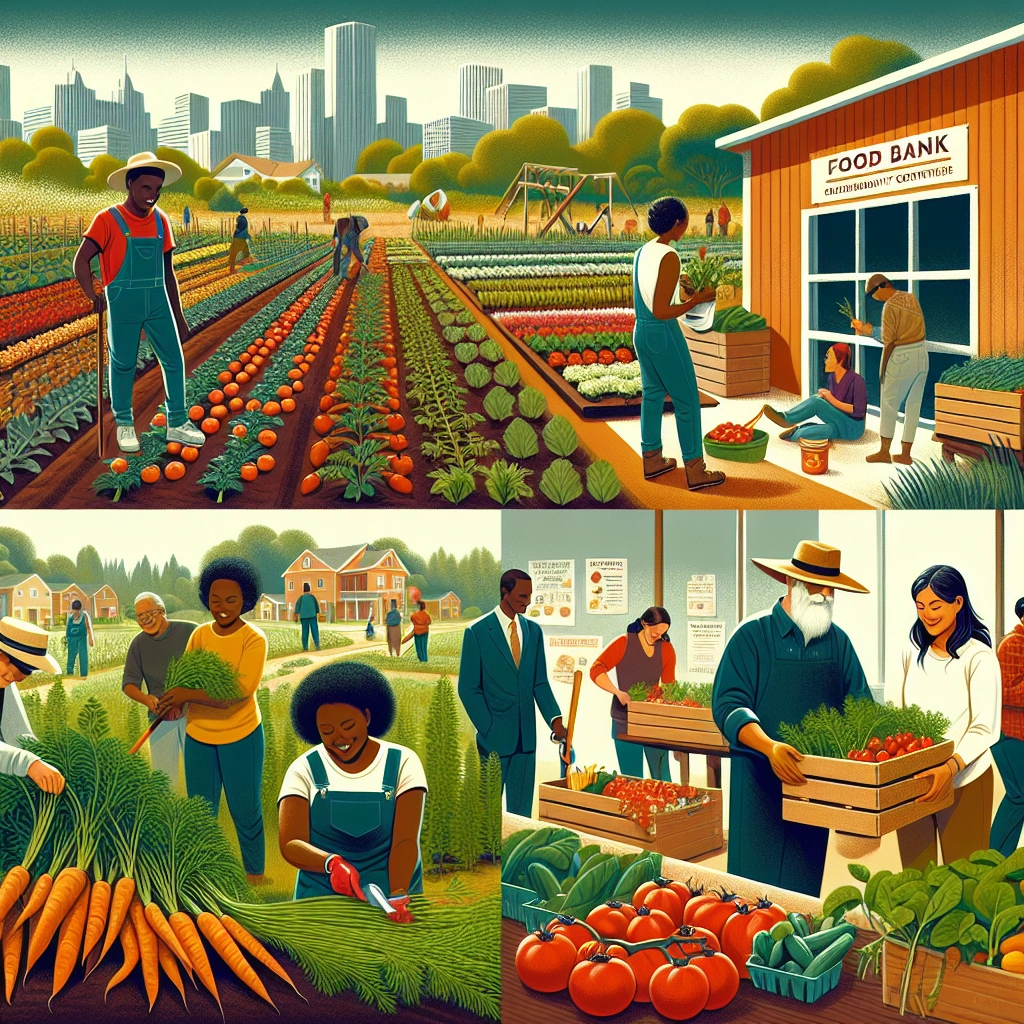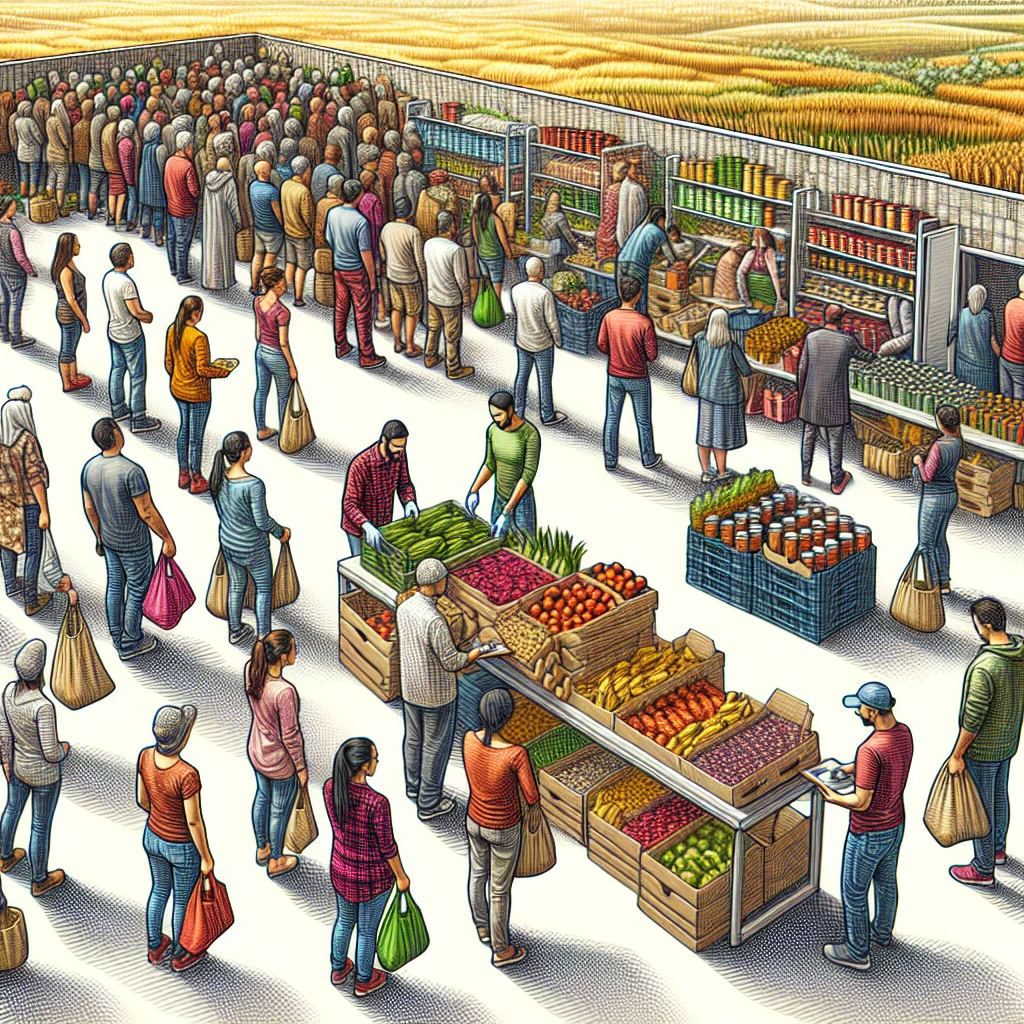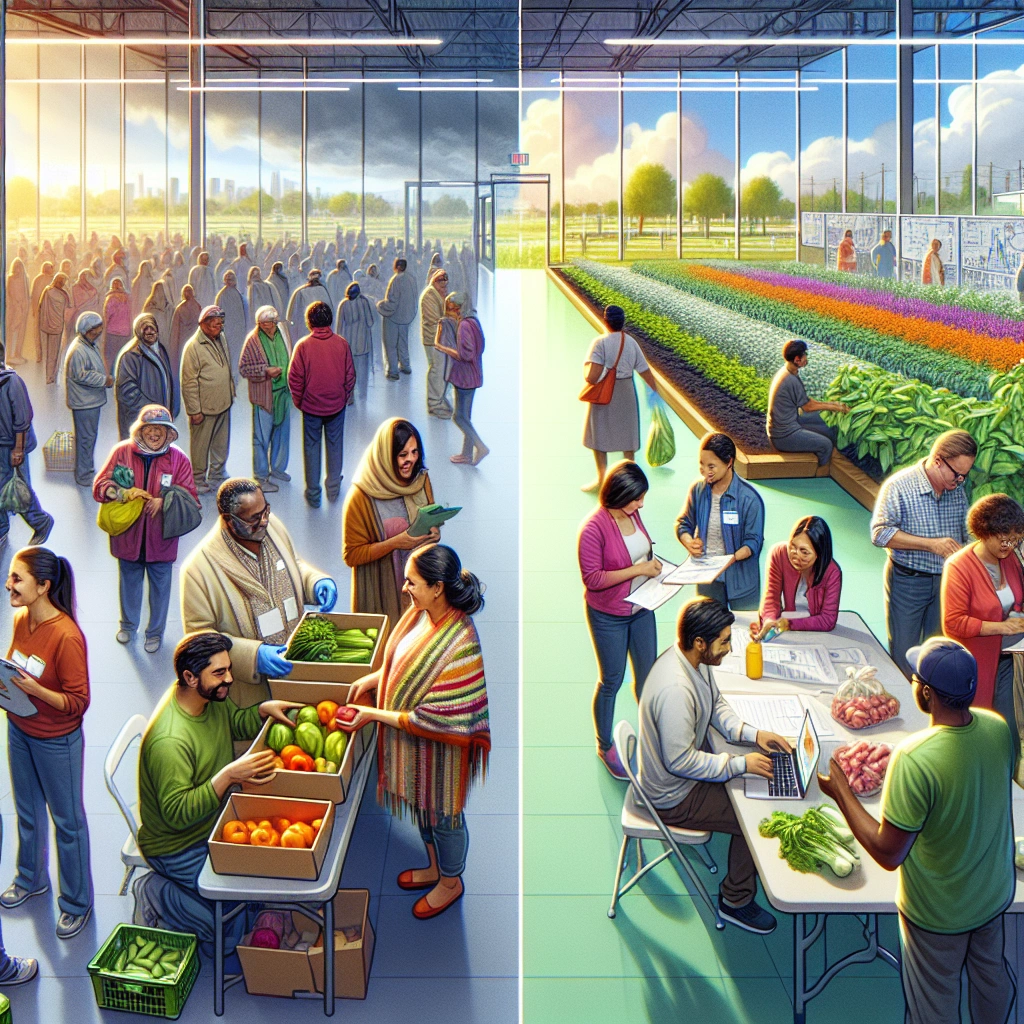

Food insecurity is the limited or uncertain availability of nutritionally adequate and safe foods, or limited ability to acquire acceptable foods in socially acceptable ways. Policies to address food insecurity are essential in ensuring that all individuals have consistent access to enough food for an active, healthy life.
Implementing effective policies to address food insecurity is important in reducing poverty, hunger, and improving overall health and economic mobility in communities. Food assistance programs and strong safety net programs play a crucial role in alleviating food insecurity and protecting individuals and families from economic shocks and emergencies.
Upstream strategies, such as creating jobs, raising wages, and improving government income, also contribute to addressing food insecurity and promoting food security at a household level.
Check out this Youtube video: “Policies to Build Food Security – YouTube” for insightful information on how policies can address food insecurity.
Understanding Food Insecurity
Definition of food insecurity
Food insecurity refers to the lack of consistent access to enough food for an active, healthy life. This arises due to financial constraints and limited resources, making it difficult for individuals and families to afford nutritious meals.
This often leads to situations where individuals must compromise on the quality and quantity of their food intake. In severe cases, it can lead to hunger and malnutrition, impacting overall well-being.
Factors contributing to food insecurity
Several factors contribute to food insecurity, including poverty, unemployment, and inadequate access to healthcare. Low income and lack of affordable housing also play a significant role in exacerbating food insecurity.
Chronic health conditions, along with the absence of reliable healthcare options, further compound the issue, making it challenging for individuals to procure essential nutritional resources.
Impacts of food insecurity on individuals and communities
The impacts of food insecurity extend beyond individuals and permeate into the broader community. For individuals, food insecurity can result in serious health issues, as they may have to make difficult choices between purchasing food and essential medications.
Additionally, food insecurity can hinder a child’s learning and development, leading to long-term repercussions. At the community level, persistent food insecurity can strain local healthcare systems and lead to increased rates of chronic diseases, affecting the overall well-being of the population.
| Factors contributing to food insecurity | Impacts of food insecurity on individuals and communities |
|---|---|
| – Poverty, unemployment, or low income | – Serious health issues for individuals |
| – Lack of affordable housing | – Hindered child learning and growth |
| – Chronic health conditions | – Strain on local healthcare systems |
The issue of food insecurity requires strategic and compassionate policies that address its fundamental causes and provide sustainable solutions. By focusing on poverty alleviation, employment opportunities, affordable housing, and accessible healthcare, policymakers can mitigate the impacts of food insecurity and foster healthier, more secure communities.
Current Policies and Programs
Overview of existing policies and programs
The current policies and programs addressing food insecurity in the United States include federal nutrition assistance programs like SNAP (Supplemental Nutrition Assistance Program), WIC (Special Supplemental Nutrition Program for Women, Infants, and Children), and school meal programs. These programs aim to provide vital assistance to low-income individuals and families, ensuring access to nutritious food.
Analysis of their effectiveness
An analysis of these programs reveals a mixed effectiveness, with some successfully alleviating food insecurity for participants, while others may fall short in reaching those in need due to eligibility restrictions or administrative barriers. For instance, SNAP has shown effectiveness in reducing food insecurity, but challenges such as stigma and complexity may hinder its full impact.
Identification of gaps and areas for improvement
Identified gaps in the existing policies and programs include limited access to affordable, nutritious foods in underserved communities, especially in rural and urban food deserts. Additionally, gaps in coordination between federal and local-level initiatives have been recognized, highlighting the need for improved collaboration and resource allocation to address food insecurity comprehensively.
| Gap | Description |
|---|---|
| Limited Access to Healthy Foods | Inadequate availability of fresh, healthy foods in certain geographic areas |
| Coordination and Collaboration | Need for enhanced cooperation between federal and local programs to maximize impact and reach |
While existing policies and programs have made strides in combating food insecurity, there is a pressing need to address identified gaps and areas for improvement to ensure more effective and comprehensive support for vulnerable populations.
Challenges in Addressing Food Insecurity
Barriers to accessing nutritious food
The barriers to accessing nutritious food are multifaceted and include factors such as distance to grocery stores and lack of transportation. This can inhibit access to healthy food options, especially in rural or low-income areas.
Additionally, time constraints and competing priorities, along with the cost of healthy food, contribute to barriers in accessing nutritious options.
Socioeconomic factors influencing food insecurity
Socioeconomic factors play a significant role in influencing food insecurity. For instance, households with lower income levels face challenges in purchasing power and are often at a higher risk of food insecurity.
Similarly, disabled adults and children with unemployed parents are more vulnerable to food insecurity due to limited employment opportunities and reduced income available to buy food.
Impact of natural disasters and emergencies
Natural disasters and emergencies can have a substantial impact on food security. Events such as hurricanes, floods, and droughts directly affect the availability of food, leading to shortages and disruptions in the food supply chain.
These disasters pose significant challenges toward achieving food security, especially for vulnerable populations living in disaster-prone regions.
| Challenges | Impacts |
|---|---|
| Lack of transportation | Inhibits access to healthy food options |
| Time constraints | Competing priorities |
| Cost of healthy food | Reduced purchasing power for vulnerable households |
| Limited employment opportunities | Reduced income available to buy food |
| Hurricanes, floods, and droughts | Shortages and disruptions in the food supply chain |
Policy Approaches to Address Food Insecurity
Expansion of food assistance programs
The government is increasing funding for The Emergency Food Assistance Program (TEFAP) and the Commodity Supplemental Food Program (CSFP) to provide more support to food banks and local communities. This entails investing in sourcing local foods for emergency nutrition assistance, fostering a more sustainable and effective food distribution system.
Promoting community food initiatives
Local and community food initiatives are being championed to improve the health and sustainability of food systems by enhancing market support and creating opportunities for local economies. By promoting these initiatives, the government aims to tackle food insecurity at the grassroots level and empower communities to address their own food needs.
Implementing sustainable agricultural strategies
| The U. S. Government is implementing strategies to promote sustainable agricultural practices and food systems globally. These strategies focus on increasing productivity, reducing waste, and supporting local and regional food systems.
By promoting sustainable agriculture, the government aims to transform food production towards greater efficiency and effectiveness, contributing to long-term solutions for food insecurity both domestically and internationally. |
The holistic approach to addressing food insecurity encompasses expanding food assistance programs, promoting community food initiatives, and implementing sustainable agricultural strategies. These policy initiatives are aimed at creating a more resilient and sustainable food system, empowering local communities, and fostering long-term solutions to address food insecurity at its core.
Legislative Efforts to Combat Food Insecurity
Advocacy for government funding
Advocating for government funding is crucial to address food insecurity at a national level. By leveraging data on the impact of food insecurity, policymakers can be urged to allocate substantial resources towards hunger relief programs and initiatives.
For instance, mobilizing support for federal grants to expand community food security projects can ensure better access to nutritious food for vulnerable populations.
Development of food security legislation
Developing comprehensive food security legislation is essential to establish a structured framework for addressing the root causes of food insecurity. This includes drafting bills that prioritize funding for food assistance programs, incentivize sustainable agriculture, and promote food education initiatives.
Moreover, implementing policies that prioritize local food production and distribution can significantly contribute to long-term food security.
Collaboration with policymakers and stakeholders
Collaborating with policymakers and stakeholders is pivotal to ensure the effective implementation of food security measures. Engaging in meaningful dialogues with legislators, agricultural organizations, and community leaders can lead to the development of impactful policies.
By fostering partnerships with diverse stakeholders, it becomes possible to create holistic strategies that address various facets of food insecurity, from production and distribution to education and access.
| Initiatives for Collaboration | Description |
|---|---|
| Public-Private Partnerships | Engaging with private corporations and organizations to leverage resources and expertise for food security initiatives. |
| Community Input Forums | Holding forums to gather input from local communities to shape legislation that directly addresses their specific food insecurity challenges. |
With a collective effort focused on advocating for funding, developing robust legislation, and fostering collaboration, policymakers, and stakeholders can work toward a more food-secure future for all Americans.
International Efforts and Global Impact
Comparison of food insecurity policies worldwide
| Country | Policy Approach |
|---|---|
| United States | Focuses on community gardens and food banks |
| Canada | Emphasizes subsidized healthy food options |
| India | Implements government-subsidized food programs |
Examination of successful international approaches
- The United States focuses on community gardens and food banks to address food insecurity at the grassroots level.
- Canada’s approach includes the provision of subsidized healthy food options to ensure accessibility for all citizens.
- India implements government-subsidized food programs to directly support vulnerable populations.
Global initiatives to address food insecurity
- The World Food Programme provides humanitarian assistance to support people vulnerable to food insecurity on a global scale.
- The U. S. Government’s Global Food Security Strategy aims to end global hunger, poverty, and malnutrition through an integrated whole-of-government approach.
- The Food and Agriculture Organization (FAO) works to help eliminate hunger, food insecurity, and malnutrition as part of its strategic objectives.
“`
Public-Private Partnerships for Food Security
Collaboration between corporations and non-profit organizations
Collaboration between corporations and non-profit organizations is crucial for addressing food insecurity. As an example, the collaboration between the World Food Programme and various corporate partners such as Cargill and Mastercard has enabled the delivery of vital food assistance to vulnerable communities worldwide.
By leveraging corporate resources and expertise, non-profit organizations can amplify their impact and reach more people in need.
Impact of corporate social responsibility initiatives
Corporate social responsibility initiatives play a significant role in addressing food insecurity. For instance, the partnership between Feeding America and Walmart showcases the positive impact of corporate initiatives.
Through food donation programs and hunger relief efforts, Walmart has been able to make a tangible difference in combatting food insecurity, illustrating the substantial impact of corporate social responsibility on addressing this critical issue.
Case studies of successful partnerships
| Partner Organizations | Impact |
|---|---|
| UN World Food Programme | – Successful implementation of food assistance programs |
| Cargill | – Contribution to sustainable agriculture and food security |
| Feeding America | – Effective food donation programs to alleviate food insecurity |
These successful partnerships demonstrate how collaborative efforts between corporations and non-profit organizations can lead to meaningful and sustainable outcomes in the fight against food insecurity.
Innovations in Food Distribution and Access
Utilizing technology to improve food access
Technology is revolutionizing food access, with innovations like automated processing, drones for efficient distribution, and robots for picking and packing. These technologies streamline production and distribution, ensuring quicker and more efficient access to food for consumers.
Addressing transportation barriers in underserved communities
Transportation barriers in underserved communities are being addressed through innovative solutions such as community-based transportation services, mobile food delivery units, and partnerships with ride-sharing companies. These initiatives aim to ensure that residents in these areas have reliable and convenient access to essential food supplies.
Implementing online food delivery programs
Online food delivery programs are gaining momentum as a convenient and efficient way to deliver food to consumers’ doorsteps. With the increasing reliance on online platforms, these programs offer a seamless and accessible means for individuals to access a variety of food options without the need to physically travel to stores.
| Technology | Benefits | Examples |
|---|---|---|
| Automated processing | Streamlines production and distribution | Automated sorting systems |
| Drones | Efficient distribution | Drone delivery services |
| Robots | Quick and efficient packing | Robotic packing systems |
These innovations are transforming food distribution and access, ensuring that individuals in both urban and rural areas have timely and convenient access to essential food supplies.
Education and Awareness Campaigns
Importance of nutrition education
Nutrition education plays a crucial role in empowering individuals to make informed decisions about their diet and overall health. By providing essential knowledge about the impact of healthy eating on emotional well-being, nutrition education equips individuals with the tools to recognize the link between emotions and dietary choices.
This awareness fosters a greater appreciation for the role of nutrition in maintaining overall wellness.
Promoting healthy eating habits
Promoting healthy eating habits is essential in cultivating a supportive food environment. It requires collaboration across various sectors and stakeholders, including government, public, and private entities.
Through initiatives that encourage the consumption of nutritious foods and limit unhealthy dietary practices, individuals can embrace healthier lifestyles. This proactive approach fosters sustainable, positive dietary behaviors and contributes to improved overall well-being.
Addressing stigma associated with food insecurity
Addressing the stigma associated with food insecurity is paramount in ensuring equitable access to nourishment for all individuals. Efforts to reduce stigma, particularly in programs such as SNAP and the Special Supplemental Nutrition Program for Women, Infants, and Children, have resulted in increased enrollment.
Additionally, creating universal meal programs in schools and implementing stigma-combating messaging are effective strategies that contribute to a more inclusive and supportive approach to addressing food insecurity.
| Initiatives to Address Stigma |
|---|
| 1. Universal meal programs in schools |
| 2. Messaging strategies to combat stigma |
| 3. Increased enrollment in nutrition assistance programs |
These efforts collectively contribute to the establishment of an environment where individuals feel empowered and supported in their pursuit of nourishment and well-being.
Addressing Food Insecurity in Rural Communities
Challenges unique to rural areas
Rural communities face distinct challenges exacerbating food insecurity, including limited access to grocery stores, insufficient public transportation, and employment opportunities with low wages. These factors combine to create a formidable barrier to obtaining affordable, nutritious food.
Policies tailored for rural food access
Implementing policies tailored for rural food access is crucial to addressing food insecurity. Initiatives such as funding support for farmers’ markets, improving transportation infrastructure, and incentivizing grocery store development in underserved areas can significantly enhance food availability in rural communities.
Success stories in addressing rural food insecurity
Several success stories demonstrate the effectiveness of targeted interventions in combating rural food insecurity. For instance, the implementation of mobile food pantries, community garden programs, and public-private partnerships has yielded remarkable improvements in food access and nutrition outcomes for residents in rural areas.
These success stories serve as beacons of hope and inspiration for further initiatives to address food insecurity in rural communities.
The Role of Healthcare in Addressing Food Insecurity
Incorporating food security screening in healthcare settings is crucial for identifying and addressing food insecurity among patients. By implementing routine screening protocols, healthcare providers can identify individuals at risk and provide the necessary support and resources to alleviate food insecurity.
Screening tools such as the Hunger Vital Sign can be integrated into electronic health records to streamline the process and ensure comprehensive assessment.
Providing nutrition counseling and support is an essential component of healthcare interventions to address food insecurity. Healthcare professionals play a pivotal role in offering personalized nutrition guidance, creating tailored meal plans, and facilitating access to community resources such as food banks and nutrition assistance programs.
By empowering patients with nutritional knowledge and resources, healthcare providers contribute to long-term food security outcomes.
Collaboration between healthcare providers and community organizations is instrumental in fostering a holistic approach to addressing food insecurity. By establishing partnerships with local food banks, community outreach programs, and governmental agencies, healthcare providers can expand their capacity to address the multifaceted challenges associated with food insecurity.
This collaborative effort enhances the accessibility of vital resources and amplifies the impact of interventions aimed at improving food security.
| Benefits of Collaboration | Enhanced access to food assistance programs and resources |
|---|---|
| Strengthened community support networks | Comprehensive care and support for individuals facing food insecurity |
The role of healthcare in addressing food insecurity extends beyond medical treatment to encompass proactive measures such as screening, nutritional counseling, and collaborative partnerships. By integrating these strategies into clinical practices, healthcare providers can significantly contribute to mitigating the detrimental effects of food insecurity on individuals’ health and well-being.
Measuring the Impact of Food Insecurity Policies
Evaluation metrics for success
To measure the success of policies addressing food insecurity, key evaluation metrics should include the percentage of households receiving food assistance, the reduction in food deserts, and the increase in food bank donations as indicators of improved access to food resources.
Data collection and analysis
Data collection and analysis for assessing the impact of food insecurity policies require tracking metrics such as food assistance program participation rates, household food expenditure, and poverty headcount ratio at $1.25, which provide insights into the effectiveness of the policies in alleviating food insecurity.
Impact on health outcomes and economic development
The impact of these policies on health outcomes and economic development can be gauged through metrics like reduced rates of malnutrition, improvement in overall public health, increased labor force participation, and decreased healthcare costs due to a healthier and more food-secure population.
Advocacy and Community Engagement
Empowering communities to address food insecurity
We must empower communities to address food insecurity by creating local initiatives such as community gardens, food cooperatives, and cooking workshops. These efforts can involve residents in producing and accessing nutritious food, fostering a sense of ownership and empowerment.
Grassroots advocacy for policy change
Grassroots advocacy for policy change is crucial in addressing food insecurity. By organizing community meetings, engaging with local representatives, and mobilizing community members, we can push for policy reforms that ensure access to affordable, nutritious food for all.
Mobilizing support for food security initiatives
Mobilizing support for food security initiatives involves raising awareness and garnering support from local businesses, community leaders, and organizations. By organizing fundraising events, food drives, and collaborative partnerships, we can ensure sustained resources and backing for vital food security programs.
Overcoming Resistance and Counterarguments
Addressing skepticism about government intervention
Skepticism about government intervention can be valid, but when it comes to ensuring food safety, it’s imperative to recognize the positive impact of well-designed policies. By highlighting successful government interventions in the past, such as the implementation of food safety regulations and quality control standards, we can showcase the tangible benefits of government involvement in ensuring a secure food supply.
Responding to criticisms of food assistance programs
Criticism of food assistance programs often stems from misconceptions about their efficacy and impact. It’s essential to address these criticisms by providing real-life success stories of individuals and families who have benefited from these programs. Additionally, highlighting the role of food assistance programs in supporting vulnerable communities during times of crisis can help debunk unfounded criticisms and showcase their value.
Debunking myths about food insecurity
Debunking myths about food insecurity requires shedding light on the pervasive misconceptions that perpetuate stigmatization. By sharing powerful personal stories and statistics, we can dispel myths such as “food insecurity only impacts certain groups,” showing that it can affect individuals from all walks of life. Furthermore, providing concrete examples of successful interventions that have alleviated food insecurity can effectively challenge these harmful myths.
The Future of Food Insecurity Policies
Emerging trends in policy development
Policies to address food insecurity are seeing a shift towards a more holistic approach, incorporating factors like community engagement, education, and sustainable agriculture. Governments are increasingly focusing on targeted interventions to address specific vulnerabilities in food access, rather than generic solutions.
Innovations in food security solutions
Innovations in food security solutions are centered around technology integration, such as mobile applications for food assistance, smart agriculture techniques, and blockchain for transparent supply chains. Additionally, community-driven initiatives like urban gardening and community kitchens are gaining momentum as practical, grassroots solutions.
Predictions for the future of addressing food insecurity
The future of addressing food insecurity is predicted to involve a blend of policy reforms, technological advancements, and societal collaboration. Proactive measures will likely prioritize early intervention, resilient food systems, and equitable access, aiming to create sustainable, long-term solutions for food insecurity challenges.
| Example | Impact |
|---|---|
| Mobile Apps for Food Assistance | Enhanced accessibility to food support |
| Urban Gardening Initiatives | Localized food production and community resilience |
| Blockchain for Supply Chain Transparency | Reduced food waste and enhanced accountability |
Remember, we should embrace innovative policies, technologies, and community efforts to foster a future without food insecurity.
Recommended Amazon Products for Addressing Food Insecurity
Here’s a curated list of products that can help in addressing food insecurity with ease. These recommendations are based on functionality, price, and customer reviews.
KitchenAid Stand Mixer


The KitchenAid Stand Mixer is a versatile tool for preparing nutritious meals in bulk, which can be beneficial for community meal programs and food distribution centers. Its powerful motor and various attachments make cooking and baking more efficient and accessible, especially for those working with limited resources.
Additionally, the durable construction and positive customer reviews make it a reliable choice for long-term use.
Instant Pot Duo 7-in-1 Electric Pressure Cooker


The Instant Pot Duo Electric Pressure Cooker offers a convenient way to prepare meals quickly while retaining essential nutrients in ingredients, thus supporting efforts to provide nourishing food to individuals and families in need. Its multifunctionality and user-friendly interface make it suitable for various cooking skill levels and kitchen environments.
With high ratings and a reasonable price point, it is a cost-effective solution for food assistance programs and community kitchen initiatives.
NutriBullet High-Speed Blender/Mixer System


The NutriBullet High-Speed Blender/Mixer System facilitates the creation of nutritious and easily digestible smoothies and soups, making it an ideal choice for promoting healthy eating habits and addressing the nutritional needs of diverse populations. Its compact design and simple operation enable efficient food preparation, particularly in settings with limited space and resources.
Endorsed by positive customer feedback, this blender system offers a reliable solution for enhancing access to essential nutrients.
Hamilton Beach Electric Indoor Searing Grill


The Hamilton Beach Electric Indoor Searing Grill provides a convenient way to prepare grilled food indoors, offering a healthier cooking method compared to traditional frying and enhancing the flavors of affordable ingredients commonly distributed through food assistance programs. Its adjustable temperature control and compact size make it suitable for various kitchen setups and culinary skill levels.
With favorable customer reviews and a competitive price, it presents a practical option for expanding meal options for individuals affected by food insecurity.
Cosori Air Fryer Max XL


The Cosori Air Fryer Max XL offers a space-saving and energy-efficient solution for cooking crispy and delicious meals using minimal oil, which can be beneficial for promoting healthier eating choices among individuals facing food insecurity. Its large capacity and intuitive controls make it suitable for batch cooking and preparing a wide range of recipes, accommodating the needs of diverse households and community food initiatives.
With positive customer ratings and a reasonable price tag, it is a reliable choice for addressing dietary concerns while staying within budget constraints.
| Product | Pros | Cons |
|---|---|---|
| KitchenAid Stand Mixer | – Versatile for bulk meal preparation – Durable construction – Positive customer reviews | – Higher initial investment |
| Instant Pot Duo Electric Pressure Cooker | – Quick meal preparation – Retains essential nutrients – Cost-effective | – Learning curve for some users |
| NutriBullet High-Speed Blender/Mixer System | – Creates easily digestible meals – Compact design – Positive customer feedback | – Limited cooking methods |
| Hamilton Beach Electric Indoor Searing Grill | – Indoor grilling for healthier cooking – Adjustable temperature control – Competitive price | – Limited cooking surface |
| Cosori Air Fryer Max XL | – Space-saving and energy-efficient – Large cooking capacity – Positive customer ratings | – Limited to specific cooking methods |
Top Recommended Product for Addressing Food Insecurity
If you’re looking for the best solution for addressing food insecurity, we highly recommend the Instant Pot Duo 7-in-1 Electric Pressure Cooker. Here’s why:


The Instant Pot Duo Electric Pressure Cooker offers a convenient way to prepare meals quickly while retaining essential nutrients in ingredients, thus supporting efforts to provide nourishing food to individuals and families in need. Its multifunctionality and user-friendly interface make it suitable for various cooking skill levels and kitchen environments.
With high ratings and a reasonable price point, it is a cost-effective solution for food assistance programs and community kitchen initiatives.
Ready to improve your food assistance programs? Check out the Instant Pot Duo Electric Pressure Cooker today for the best results!


Conclusion
Policies to address food insecurity are crucial in ensuring that all individuals have access to an adequate and nutritious diet. These policies should focus on improving food distribution systems, increasing access to affordable and healthy food options, and providing support for low-income families and individuals.
Additionally, policies should prioritize addressing the root causes of food insecurity, such as poverty, unemployment, and lack of education.
Furthermore, it is essential for policies to address food insecurity to be comprehensive and collaborative, involving the participation of government agencies, nonprofit organizations, community groups, and businesses. By working together, these entities can develop and implement effective strategies to provide sustainable solutions to food insecurity.
Moreover, policies should be regularly evaluated and adjusted based on the evolving needs of the population and the changing food landscape.
Policies to address food insecurity play a critical role in promoting the well-being of individuals and communities. It is imperative for policymakers to prioritize and invest in these policies to ensure that everyone has access to an adequate and reliable food supply.
By doing so, we can work towards creating a future where food insecurity is significantly reduced, if not completely eliminated.

















